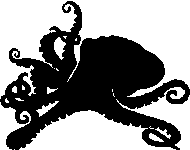Locations of the References Used

Anderson, R., Mather, J., & Wood, J.
(2010). Octopus: The Ocean’s Intelligent Invertebrate. London:
Timber Press, Inc.
Cooper, A., Drummond, A., Jackson, J., & Strugnell, J. (2006).
Divergence time estimates for major cephalopod groups: Evidence
from multiple genes. Cladistics, 22(1), 89-96.
Corning, W. C., Dyal, J. A., & Willows, A. O. D. (1975).
Invertebrate Learning: Cephalopods and Echinoderms. New York:
Plenum.
Cowles, D. (2005). Walla Walla University. Retrieved from <http://www.wallawalla.edu/academics/departments/biology/rosario/inverts/Mollusca/
Cephalopoda/Enteroctopus_dofleini.html>
Accessed on 4/12/2012.
Cruz-Leyva, M.C., Zamudio-Maya, M., Corona-Cruz, A.I.,
Gonzalez-de la Cruz, J.U., & Rojas-Herrera, R. (2011) A method for
isolating RNA from metabolically active bacterial flora associated
with octopus. The Society for Applied Microbiology, 53(1), 8-13.
Frank, L. (1974). Kingdom of the Octopus. New York:
Sheridan House.
Horton, J. (2011). How octopuses work. Retrieved from <http://science.howstuffworks.com/environmental/life/zoology/marine-life/octopus5.htm>
Accessed on 4/12/2012.
Line, L. (2009). One picture. Audubon, 11(2), 124.
Marine Bio.
(2012). Retrieved from <http://marinebio.org/species.asp?id=60>
Accessed on 4/12/2012.
Monterey Bay Aquarium. (2012). Retrieved from <http://www.montereybayaquarium.org/animals/AnimalDetails.aspx?enc=3R3lP3a1nfYypGmlhi/a8Q> Accessed
on 4/12/2012.
National Zoological Park. (2010). Retrieved from <http://nationalzoo.si.edu/Animals/Invertebrates/Facts/cephalopods/FactSheets/
Pacificoctopus.cfm>
Accessed on 4/12/2012.
Scheel, D. (2005). Alaska Pacific. Retrieved from <http://marine.alaskapacific.edu/octopus/factsheet.html#Suckers>
Accessed on 4/12/2012.
Tennesen, M. (2003). Outsmarting the competition.
National Wildlife, 41(1), 30-37.
Wood, J. (2012). The Cephalopod
Page. Retrieved from <http://www.thecephalopodpage.org/octopoda.php>
Accessed on 4/12/2012.
Back to Fun Facts Forward to About the Author